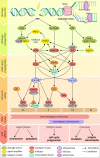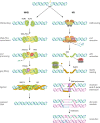Radio-resistant mesenchymal stem cells: mechanisms of resistance and potential implications for the clinic
- PMID: 26203772
- PMCID: PMC4637291
- DOI: 10.18632/oncotarget.4358
Radio-resistant mesenchymal stem cells: mechanisms of resistance and potential implications for the clinic
Abstract
Mesenchymal stem cells (MSCs) comprise a heterogeneous population of multipotent stromal cells and can be isolated from various tissues and organs. Due to their regenerative potential, they have been subject to intense research efforts, and they may provide an efficient means for treating radiation-induced tissue damage. MSCs are relatively resistant to ionizing radiation and retain their stem cell characteristics even after high radiation doses. The underlying mechanisms for the observed MSC radioresistance have been extensively studied and may involve efficient DNA damage recognition, double strand break repair and evasion of apoptosis. Here, we present a concise review of the published scientific data on the radiobiological features of MSCs. The involvement of different DNA damage recognition and repair pathways in the creation of a radioresistant MSC phenotype is outlined, and the roles of apoptosis, senescence and autophagy regarding the reported radioresistance are summarized. Finally, potential influences of the radioresistant MSCs for the clinic are discussed with respect to the repair and radioprotection of irradiated tissues.
Keywords: double strand break; mesenchymal stem cell; radiotherapy; tissue regeneration.
Conflict of interest statement
there is no conflict of interest.
Figures


Similar articles
-
The Radiation Resistance of Human Multipotent Mesenchymal Stromal Cells Is Independent of Their Tissue of Origin.Int J Radiat Oncol Biol Phys. 2018 Apr 1;100(5):1259-1269. doi: 10.1016/j.ijrobp.2018.01.015. Epub 2018 Jan 9. Int J Radiat Oncol Biol Phys. 2018. PMID: 29452769
-
Multiple facets of the DNA damage response contribute to the radioresistance of mouse mesenchymal stromal cell lines.Stem Cells. 2013 Jan;31(1):137-45. doi: 10.1002/stem.1222. Stem Cells. 2013. PMID: 22961695
-
Mesenchymal stem cells are resistant to carbon ion radiotherapy.Oncotarget. 2015 Feb 10;6(4):2076-87. doi: 10.18632/oncotarget.2857. Oncotarget. 2015. PMID: 25504442 Free PMC article.
-
Mesenchymal stem cells – A new hope for radiotherapy-induced tissue damage?Cancer Lett. 2015 Oct 1;366(2):133-40. doi: 10.1016/j.canlet.2015.06.012. Epub 2015 Jul 9. Cancer Lett. 2015. PMID: 26166559 Review.
-
Mesenchymal stem cells for tissue engineering and regenerative medicine.Biomed Mater. 2006 Jun;1(2):63-71. doi: 10.1088/1748-6041/1/2/003. Epub 2006 Apr 26. Biomed Mater. 2006. PMID: 18460758 Review.
Cited by
-
CD40 Activity on Mesenchymal Cells Negatively Regulates OX40L to Maintain Bone Marrow Immune Homeostasis Under Stress Conditions.Front Immunol. 2021 May 18;12:662048. doi: 10.3389/fimmu.2021.662048. eCollection 2021. Front Immunol. 2021. PMID: 34084166 Free PMC article.
-
Sarcandra glabra (Caoshanhu) protects mesenchymal stem cells from oxidative stress: a bioevaluation and mechanistic chemistry.BMC Complement Altern Med. 2016 Oct 28;16(1):423. doi: 10.1186/s12906-016-1383-7. BMC Complement Altern Med. 2016. PMID: 27793132 Free PMC article.
-
Therapeutic Irradiation: Consequences for Bone and Bone Marrow Adipose Tissue.Front Endocrinol (Lausanne). 2019 Aug 29;10:587. doi: 10.3389/fendo.2019.00587. eCollection 2019. Front Endocrinol (Lausanne). 2019. PMID: 31555210 Free PMC article. Review.
-
Evidence for Recombinant GRP78, CALR, PDIA3 and GPI as Mediators of Genetic Instability in Human CD34+ Cells.Cancers (Basel). 2022 Jun 11;14(12):2883. doi: 10.3390/cancers14122883. Cancers (Basel). 2022. PMID: 35740549 Free PMC article.
-
Influence of Super-Low-Intensity Microwave Radiation on Mesenchymal Stem Cells.Int J Mol Sci. 2025 Feb 17;26(4):1705. doi: 10.3390/ijms26041705. Int J Mol Sci. 2025. PMID: 40004170 Free PMC article. Review.
References
-
- Friedenstein AJ, Deriglasova UF, Kulagina NN, Panasuk AF, Rudakowa SF, Luria EA, Ruadkow IA. Precursors for fibroblasts in different populations of hematopoietic cells as detected by the in vitro colony assay method. Experimental hematology. 1974;2:83–92. - PubMed
-
- Morikawa S, Mabuchi Y, Kubota Y, Nagai Y, Niibe K, Hiratsu E, Suzuki S, Miyauchi-Hara C, Nagoshi N, Sunabori T, Shimmura S, Miyawaki A, Nakagawa T, Suda T, Okano H, Matsuzaki Y. Prospective identification, isolation, and systemic transplantation of multipotent mesenchymal stem cells in murine bone marrow. The Journal of experimental medicine. 2009;206:2483–2496. - PMC - PubMed
-
- Ho AD, Wagner W, Franke W. Heterogeneity of mesenchymal stromal cell preparations. Cytotherapy. 2008;10:320–330. - PubMed
-
- Chen BY, Wang X, Chen LW, Luo ZJ. Molecular targeting regulation of proliferation and differentiation of the bone marrow-derived mesenchymal stem cells or mesenchymal stromal cells. Curr Drug Targets. 2012;13:561–571. - PubMed
Publication types
MeSH terms
LinkOut - more resources
Full Text Sources
Other Literature Sources

